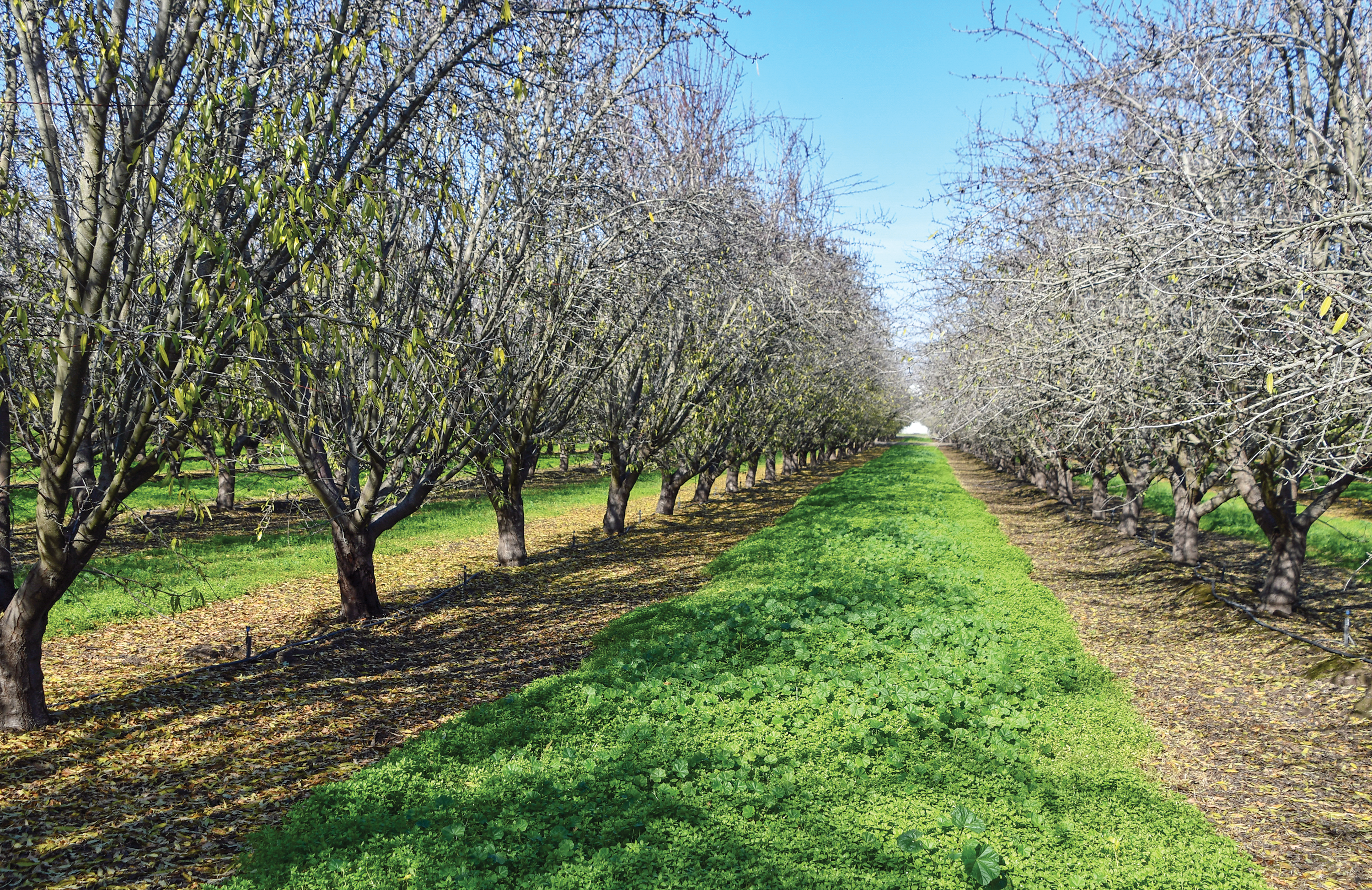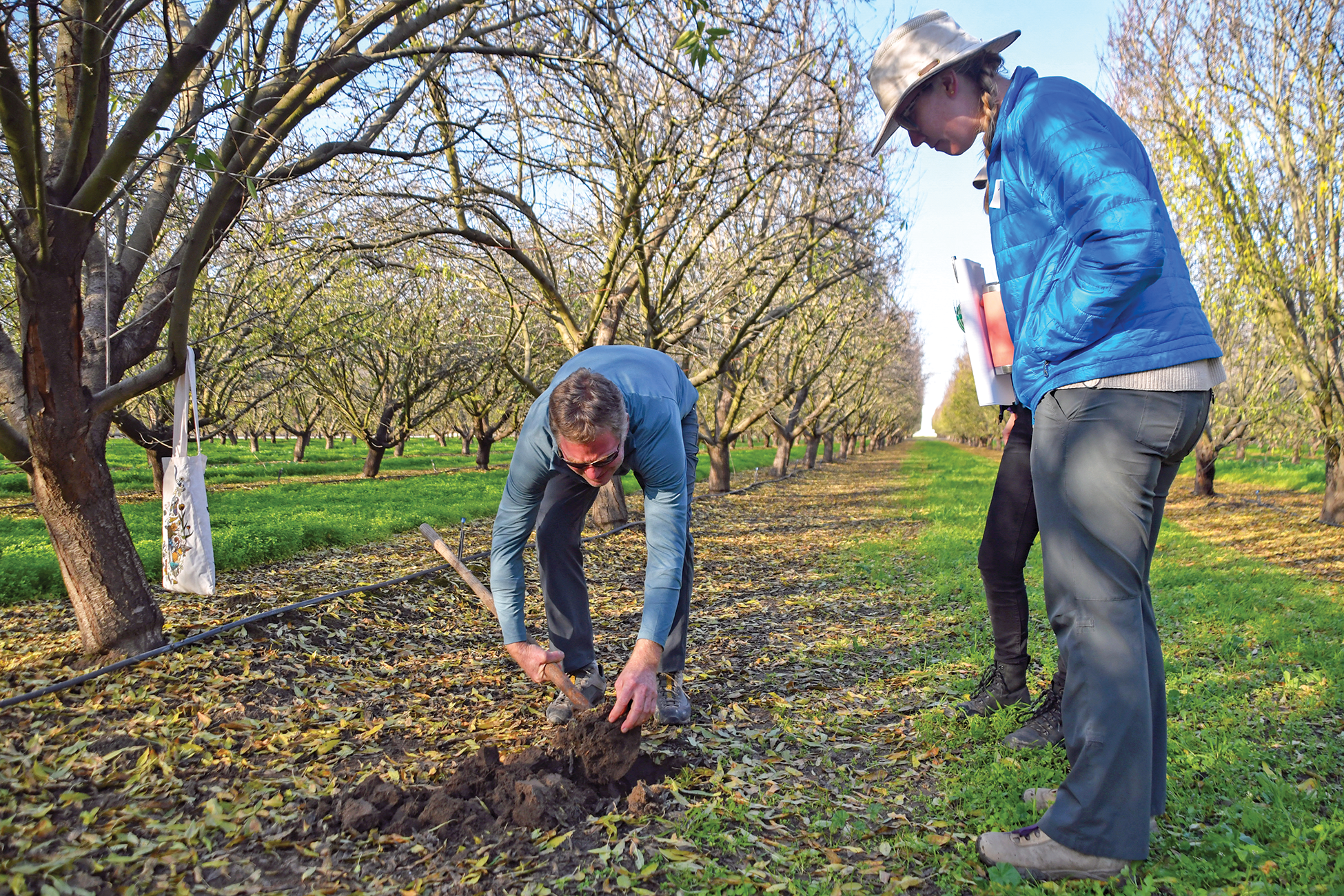Farmer demonstrations help promote cover crops


By Vicky Boyd
Rich Gemperle likes to describe his family’s crop production style as “soft farming,” in which they try to leave the lightest footprint possible on the ground. To prove his point, he recently dug a shovelful of soil in a 67-acre almond orchard planted on formerly compacted dairy ground near Ceres.
“Earthworms are like canaries in a coal mine,” Gemperle said as he smiled and pointed to the beneficial pink wigglers in the soil. “You can see the (soil) structure and see the activity, and we’re not even talking about the microbiologic activity.”
Together with daughter Tanya Gemperle-Goncalves, Gemperle grows about 1,800 acres of almonds in Merced and Stanislaus counties. While about 85% of their acreage remains conventionally farmed, they are slowly transitioning more of it into certified organic production, a task that takes at least three years.
They discussed their approach to sustainability and healthy soils—which includes cover crops, nutrient budgeting and applying composted poultry manure—during a recent Community Alliance with Family Farmers field tour.
The Gemperles have one of three orchard demonstration sites that are part of CAFF’s healthy soils program. The others are a walnut orchard in Colusa County and a pistachio orchard in Woodland.
The Davis-based alliance’s goal is to provide growers who might be interested in cover crops with real-world information, said Emily Ayala, CAFF ecological farming program manager. (See Page 47 for related story on farm tours and a cover-crop database.)
“We talk to the growers and document their experiences, their challenges and how they have overcome those challenges, and we share that with other growers,” Ayala said.
In addition, representatives from other groups, including Paul Lum from American Farmland Trust, discussed cost-share and other efforts to help growers get started with cover crops.
The Gemperles treat each orchard individually when deciding whether to plant cover crops or just allow native vegetation to grow. Many of those with cover crops are planted to sub-clovers.
But in the 67-acre tour block, they opted for a soil builder mix comprising at least one each grain, legume and brassica. That’s because the Gemperles are collaborating with Project Apis m., which helps provide pollinator habitat through its Seeds for Bees program.
“We’ve been cover cropping pretty consistently for a while,” Gemperle-Goncalves said, pointing to their start in 2001 with the Biological Integrated Orchard System program. “Every year we tweak the system, and we implement them in the most efficient way possible. Through the many years, we have a pretty efficient system that works for us. But again, every orchard is going to be different; every system will be different.”
Typically, they alternate orchard rows, with one being active and the next one passive. The system is applied to both conventional and organic orchards.
Active orchard rows receive about 3 to 4 tons per acre of composted poultry manure or compost and chipped tree prunings in late winter that are lightly incorporated into the soil. Gemperle said he based applications on a nitrogen budget that looks at how much the previous almond crop used, leaf tissue and soil samples, water sampling results and compost nitrogen content.
Front-loading nitrogen comes with a risk in organic orchards, he said. In conventional orchards, Gemperle can apply additional in-season nitrogen through the irrigation system should tissue testing show a nitrogen shortfall.
But he said he’s not able to come back with additional compost mid-season in organic orchards because food safety rules require him to complete applications at least 120 days before harvest.
The Gemperles acknowledge their approach to healthy soils may differ from others because they also are part of a family-owned egg operation that affords them nearly unlimited access to nitrogen-rich composted poultry manure.
The passive rows are cover cropped. In the conventional orchard middles, the Gemperles broadcast cover-crop seed using a planter they already had and to which they installed railings to keep seed out of the tree rows. A harrow towed behind the planter lightly incorporates the seed. They apply herbicides to keep the tree rows clean.
In the organic orchards, they plant cover crops tree line to tree line. During the season, they periodically make two passes down each row using a mower with a reciprocating head, which cuts close to the tree trunks. The Gemperles had been using a propane burner to control weeds in the tree rows, but they are developing a weed steamer this year because of its improved safety in wildfire-prone areas.
Depending on the blend, the cover crops can grow 1- to 2-feet tall during the winter before they mow them in February to aid frost protection. In the case of sub-clovers, Gemperle said, they typically won’t mow again until late April to allow plants to set seed heads to help with reseeding.
During the past five years, Gemperle-Goncalves has compared expenses of a conventionally farmed block excluding weed control to an organically farmed one nearby. While the results varied from year to year, organic costs averaged about 4% less per acre over the period than conventional. Where large differences arose were with weed management.
“Weed control in organic tends to be 30% more expensive than conventional,” Gemperle-Goncalves said. “That’s not due to the inputs. The big difference is the cost of labor and the cost of mowing. You’re making two passes per row.”
But one financial benefit that plays out in both types of orchards is having a ready compost supply. If they have to purchase an equivalent amount of nitrogen, Gemperle-Goncalves said, they would have to pay about 74% more.
(Vicky Boyd is a reporter based in Modesto. She may be contacted at vlboyd@att.net.)




